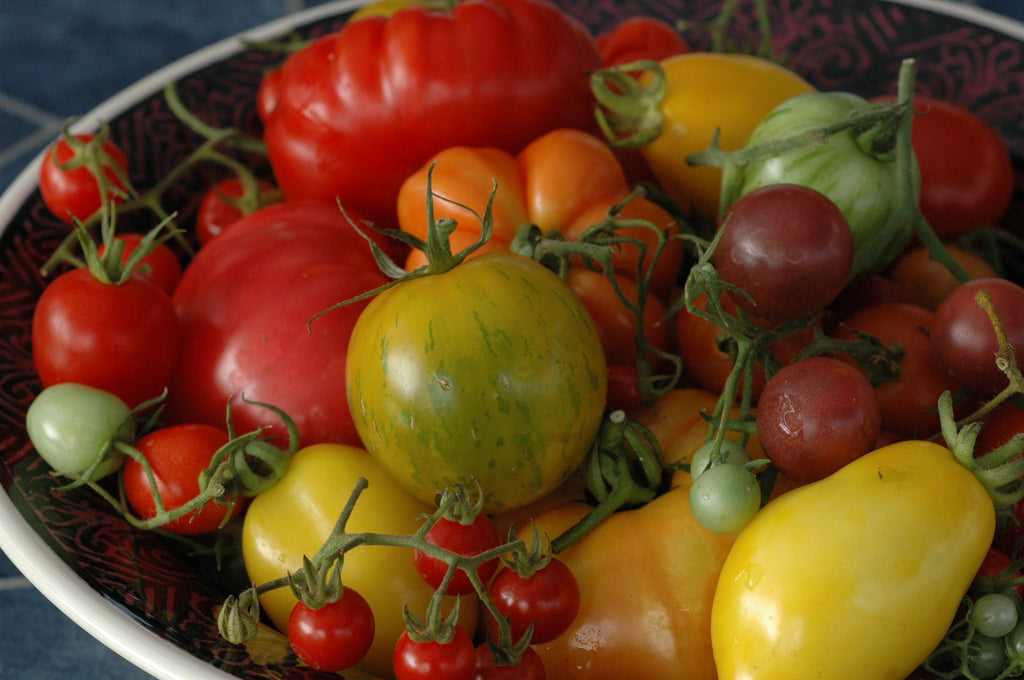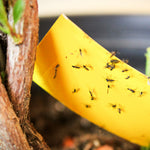 The BIG questions we have been getting lately are about tomatoes. Many gardeners are reporting trouble with spots and drying up of foliage on tomato plants and in some cases on fruits as well. This always increases anxiety that late blight could be present - which is a really significant problem when indeed confirmed.
The BIG questions we have been getting lately are about tomatoes. Many gardeners are reporting trouble with spots and drying up of foliage on tomato plants and in some cases on fruits as well. This always increases anxiety that late blight could be present - which is a really significant problem when indeed confirmed.
The good news is that late blight is not the most common cause of tomato woes. However, it can be really confusing trying to identify what exactly is causing a particular "sad" tomato situation.
As a quick over view: we have experienced unusually persistent wet conditions this summer (2016), and this is a major cause of fungal disease in the garden and landscape. The fungal spores that cause trouble are present in our environment but usually do not get out of hand because plants have natural defences against these and the spores only proliferate under the right conditions. Common fungal diseases gardeners may be familiar with are powdery mildew and the various rust diseases on roses and fruit trees. The diseases associated with tomatoes are often called "blights" - some of these are caused by fungal pathogens while others are bacterial, viral or simply associated with growing conditions.
Two types of fungal-type diseases on tomatoes include early and late blights; these are in fact quite different problems:
Early blight is caused by the fungus Alternaria solani, and as the name suggests often occurs earlier in the growing season. It is spread from the soil up to the lower leaves of the plant and moves up from there. 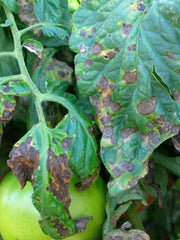 The classic symptoms include round spots with darker centres and a yellow halo around each spot (often said to look like targets'). Stems can also be damaged, with darker lesions occurring.
The classic symptoms include round spots with darker centres and a yellow halo around each spot (often said to look like targets'). Stems can also be damaged, with darker lesions occurring.
Fruits on severely infected plants will show rotting on the stem end - opposite of the common blossom end rot associated with calcium up take deficiencies.
Early blight can be treated by removing infected leaves and by spraying with copper or sulfur (on plants that are not severely infected; otherwise removing is recommended). Importantly, you can harvest the fruit from tomatoes with early blight (so long as they look healthy). Early blight unfortunately occurs on a regular basis in our area; crop rotation and mulching are two of the best ways to prevent it. 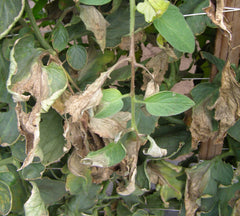 Late blight is caused by a special fungus-like pathogen called Phytophthora infestans. This is the disease that caused the great potato famine in Ireland and can be such a big deal that ag extension offices track late blight closely and there is even a US-based web tracker to show confirmed locations on a map. It is spread from infected soil, by wind, on infected garden tools and potentially on infected seed.
Late blight is caused by a special fungus-like pathogen called Phytophthora infestans. This is the disease that caused the great potato famine in Ireland and can be such a big deal that ag extension offices track late blight closely and there is even a US-based web tracker to show confirmed locations on a map. It is spread from infected soil, by wind, on infected garden tools and potentially on infected seed.
Late blight cannot be controlled through fungicides. As the name suggests, it most often occurs later in the season but can in fact happen at any point in the growing season.
Although the leaf-symptoms are somewhat similar to early blight there are several key differences. First, the leaf damage is much less likely to include round spots and the "halo" pattern associated with early blight will not be present. The damage will follow the leaf veins but at least initially will not cross the veins. Where early blight has yellow edges around dark leaf blotches, late blight will have a light coloured edge around the damaged areas. Late blight also has characteristic white spores that grow during periods of high humidity and are easily visible on damaged leaves, stems and fruits.
A simple but reliable test to confirm late blight is to place a damaged leaf on a moist paper towel and place in a zip-lock bag; leave for 12 hours (not more; not less) on top of the fridge. If white (not grey) filaments grow this is a good indication of late blight. 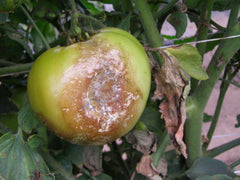 One other distinct characteristic is the damage to fruits; with late blight the fruits develop leathery brown patches that could cover much of the fruit and result in rotting and the white spores. Other types of tomato problems either do not impact the fruit or only affect a specific region (blossom end; stem end; smaller spots all over).
One other distinct characteristic is the damage to fruits; with late blight the fruits develop leathery brown patches that could cover much of the fruit and result in rotting and the white spores. Other types of tomato problems either do not impact the fruit or only affect a specific region (blossom end; stem end; smaller spots all over).
If indeed late blight is strongly suspected or confirmed, the only thing to do is remove plants and dispose of them in a double garbage bag (they should never be composted). Be sure to get all debris and dip any tools in rubbing alcohol between activities.
Unfortunately fruits are likely to develop rot even if they look healthy at time of harvest. One strategy is to dip fruits in 10% bleach / water solution which may help with storage. Any fruits that are obviously blemished should not be eaten (the late blight pathogen itself is not harmful to humans but damaged tomato tissues may harbour other types of human-unfriendly pathogens). It is also not recommended to can tomatoes from plants with late blight as the pathogen can change the fruit pH enough to render the canning process unsafe.
For gardeners with large tomato or potato plantings, it may be worth getting an official diagnosis if late blight is suspected. The University of Manitoba Crop Diagnostic Centre offers a $10 + GST plant pathology service which will identify with certainty any problem that shows up in a prairie garden (helpful for feature landscape plants and fruit trees as well). With an accurate diagnosis it is much easier to plan any required action. The Crop Diagnostic Centre is located at 201-545 University Crescent and can be reached at 204.945.7707.
(please do not bring samples of suspected late blight for inspection at Sage Garden - it is a very contagious problem and we have tomato plants growing in our greenhouses... thanks!)
Hopefully this quick run through of the blight question offers-up tools to get a better handle on any concerns you may have about tomatoes in your garden.
With best wishes for your crops!
Tomato Blights
